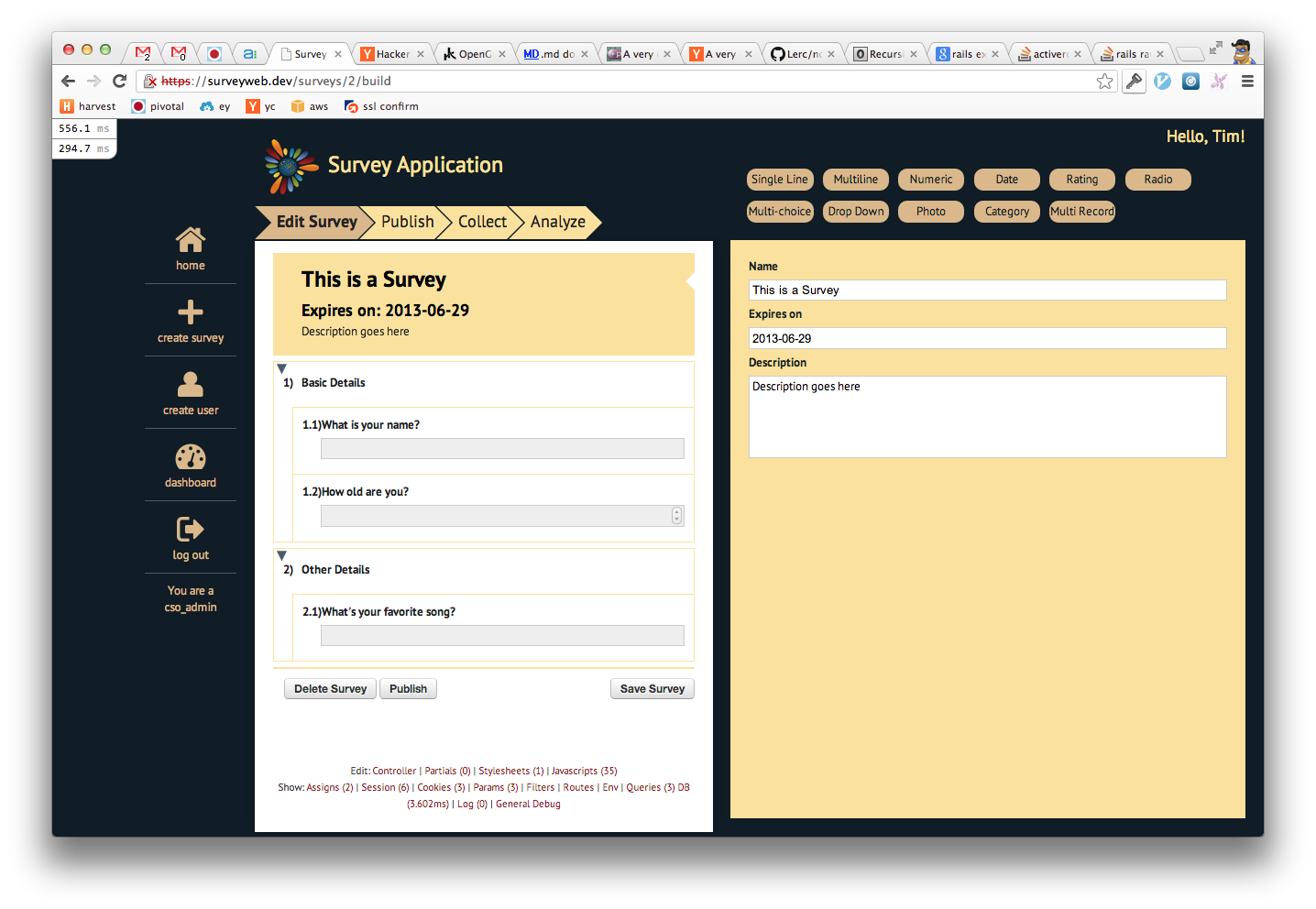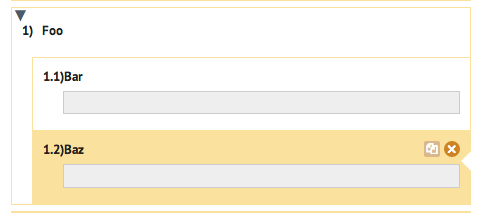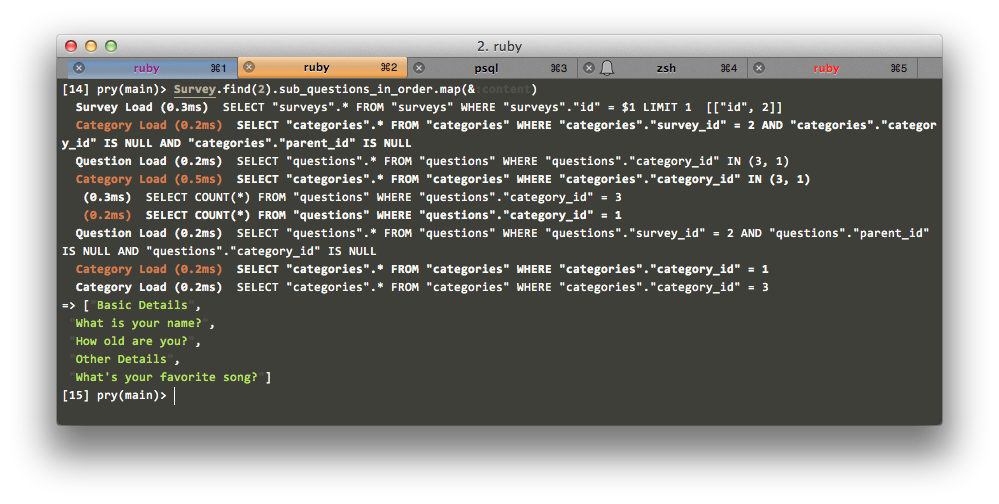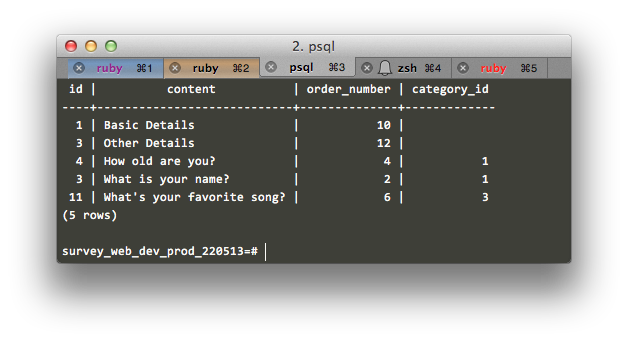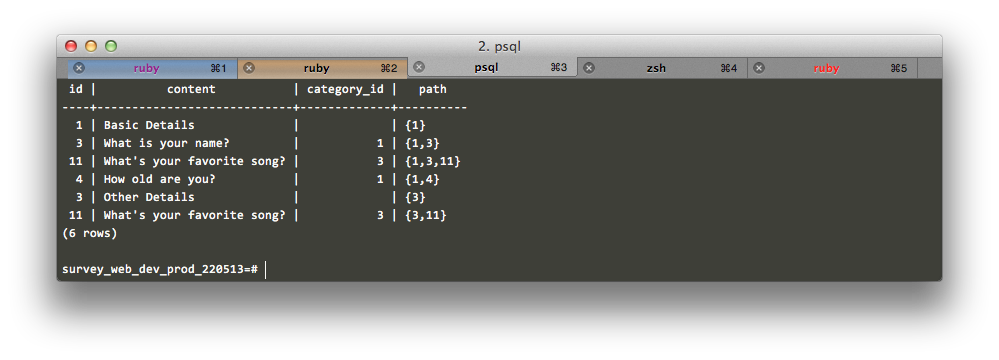Introduction
At Nilenso, I’m working on an (open-source!) app to design and conduct surveys.
Here’s a simple survey being designed:
Internally, this is represented as:
A survey is made up of many questions. A number of questions can (optionally) be grouped together in a category. Our actual data model is a bit more complicated than this (sub-questions, especially), but let’s assume that we’re just working with questions and categories.
Here’s how we preserve the ordering of questions and categories in this survey.
Each question and category has an order_number field. It’s an integer that specifies the relative ordering of itself and its siblings.
For example, in this case,
the question Bar will have an order_number that is less than the order number of Baz.
This guarantees that the a category can fetch its sub-questions in the right order:
1 2 3 4 5 | |
In fact, this is how we fetch the entire survey at this point. Each category calls sub_questions_in_order on each of its children, and so on down the entire tree.
This gives us a depth-first ordering of this tree:
For large surveys with 5+ levels of nesting, and more than a hundred questions, this is pretty slow.
Recursive Queries
I’ve used gems like awesome_nested_set before, but as far as I could find, none of them supported fetching results across multiple models.
Then I stumbled on a page describing PostgreSQL’s support for recursive queries! That seemed perfect.
Let’s solve this particular problem using recursive queries. (My understanding of this is still very basic, so please don’t take my word for any of this)
To define a recursive Postgres query, we need to define an initial query, which is called the non-recursive term.
In our case, that would be the top level questions and categories.
Top level elements don’t have a parent category, so their category_id is NULL.
1 2 3 4 5 6 7 8 9 | |
(That query, and all subsequent ones, assume that the survey we’re querying has id = 2)
This gives us the top-level elements.
Now on to the recursive term. According to the Postgres docs:
Our recursive term simply has to find all the direct children of the elements fetched by the non-recursive term.
1 2 3 4 5 6 7 8 9 10 11 12 13 14 15 16 17 18 | |
But wait. The recursive term is only fetching questions. What if the child of a first-level category is a category?
Postgres doesn’t let us reference the non-recursive term more than once. So doing a UNION of categories and questions is out.
We have to be a little creative here:
1 2 3 4 5 6 7 8 9 10 11 12 13 14 15 16 17 18 19 20 21 22 23 24 | |
We perform a UNION of categories and questions before joining it with the non-recursive term.
This yields all the survey elements:
Unfortunately, it looks like the ordering is way off.
Ordering a Recursive Query
The problem is that since we’re effectively appending second-level elements to first-level elements, we’re effectively performing a breadth-first search instead of a depth-first search.
How can we correct that?
Postgres has arrays that can be built during a query.
Let’s build an array of order numbers for each element that we fetch. Let’s call this the path. The path for an element is:
the path of it’s parent category (if one exists) + its own order_number
If we sort the final result by path, we’ve converted it into a depth-first search!
1 2 3 4 5 6 7 8 9 10 11 12 13 14 15 16 17 18 19 20 21 22 23 | |
That’s almost right. There are two entries for What’s your favourite song?
This is happening because when we do an ID comparison to look for children:
1
| |
fle contains both questions and categories. But we want this to match only categories (because questions can’t have children).
Let’s hard-code a type into each of these queries, so that we don’t try and check for children of a question:
1 2 3 4 5 6 7 8 9 10 11 12 13 14 15 16 17 18 19 20 21 22 23 24 | |
That seems about right. We’re done here.
Let’s see how much of a performance boost this gives us.
Performance
Using this script (after creating a survey from the UI), I generated 10 sub-question chains; each 6 levels deep.
1 2 3 4 5 6 7 8 | |
Each chain looks like this:
Let’s see if recursive queries are faster.
1 2 3 4 5 | |
31x faster? Not bad.

